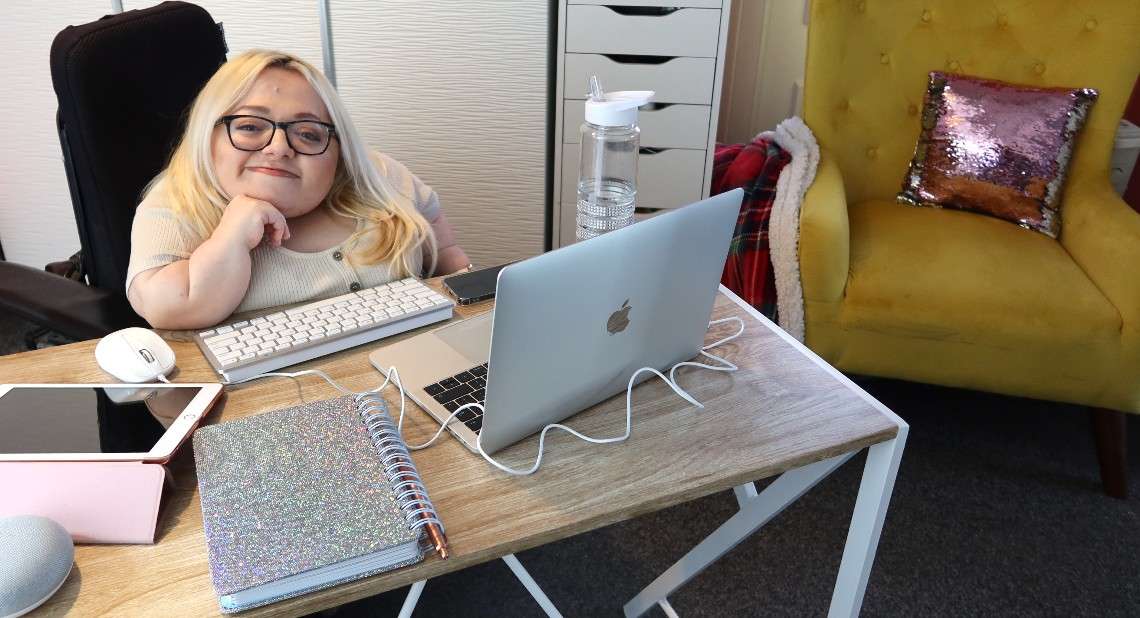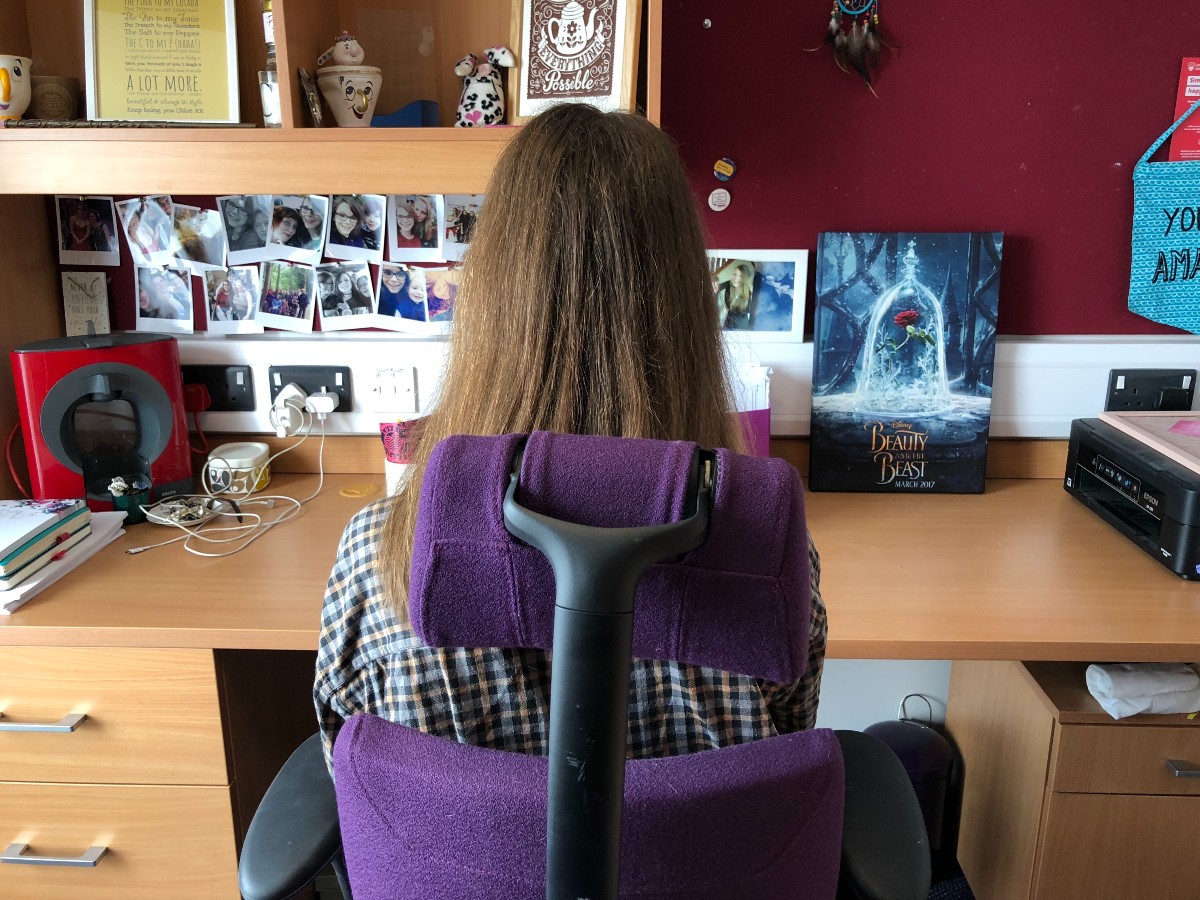Due to the changes brought about by the Covid-19 pandemic, more and more of us have been working from home. We’ve spoken to two disability bloggers about how they’ve set up their home office to make it disability-friendly. Maybe their tips could work for you?
Working productively from home has the potential to be a challenge for everybody, but more so for anyone with a disability. To help you set up your own home office, we have put together a guide covering the four key areas of setting up a disability-friendly working space with insight from disability bloggers-come-home-workers Gem Turner and Chloe Tear.
1. Furniture
Any home office needs to be set out so that it’s easy to move around without bumping into or tripping over objects, so your use of space is key. If you have bookshelves or tables, place them along walls to keep the centre of the room as open as possible.
“It’s crucial that you have a set-up that works for you,” says Chloe Tear, a disability blogger who has cerebral palsy. “If you need to get up and walk around a lot, a standing desk may help more than a regular sitting desk. If you’re going to be sat for long periods, you need a seat that is comfortable and supportive. Your set-up has to reflect your specific needs.”
If mobility is a concern, strategically placed handrails can make navigating the office much easier. For wheelchair users, factor in the space you’ll need to manoeuvre around the room and to your desk, and invest in a desk that enables you to adjust the height – allowing you to roll under and away from the desk easily.
“As a wheelchair user, I found the most important part of my office was my desk,” says Gem Turner, whose condition, osteogenesis imperfecta, is also known as brittle bones. “As someone who has regular pain, I found that your desk can really impact not just how you feel, but also how productive you are. Getting the right desk totally changed how I feel not only while I’m working, but how I feel when I finish working too.”
Rugs make navigation more problematic, while any plugs and sockets should be positioned for easy access. For the many wires it takes to run a home office, invest in a cord organiser that keeps them neatly out of the way and reduces the risk of you or anyone else tripping over them.
If you’re working at home long-term, having an established set up with everything in the right place at all times will help establish patterns and routines that will make you more productive – as well as minimise accident risks. That doesn’t mean your office space has to be bare and clinical, however. “It’s important to make it your own,” says Chloe. “My desk has photos, ornaments and quotes stuck on it. I love having a desk area that just makes me happy.”
2. Lighting
Research has shown that having an adequate amount of light in your workspace improves mood, concentration and energy levels. Too little light has the opposite effect and has been found to contribute towards depression and other deficiencies in the body, as well as causing eye strain. If you have the option, place your desk close to a window and natural light. If you don’t have that option, look to make the most of ‘ambient’ and ‘task lighting’.
Ambient lighting is your general lighting, provided primarily by ceiling and wall fixtures and used to create an even level of illumination through the room without creating the shadows that can result in eye strain. Task lighting is usually provided by a lamp that provides more focussed light where you need it most. For example, a lamp placed behind a computer screen can soften the glare of the monitor and reduce eye strain.
“As I’ve got older, I’ve realised that the seasons really do affect me,” says Gem. “I find myself bright and cheery in spring/summer and definitely more sluggish and slow in the winter/autumn. In order for me to feel the best I can, I love lighting. So I make sure I have my S.A.D. (seasonal affective disorder) lamp on in the morning and then a bright ring light when I have a particular task ahead of me.“
“I need my area to be well lit due to my level of sight,” says Chloe, who is also partially sighted due to a visual cortex disorder. “To achieve this I use lamps that have magnifiers and are adjustable so that I can position them to suit me.”
Bulbs generally need to be bright enough to illuminate your working space but not so bright they cause eye strain. A 700 lumens (60 watt) incandescent bulb should suffice, but you may need to experiment to see what works best for your space and requirements.
On all lights, use dimmer switches if you can, allowing you to adjust light levels to suit your situation – and make sure all switches can be easily reached. If you have the option, voice-activated lighting will make life far easier.
Smart home technology could be a consideration when setting up your home office. Read on here to learn how it can help maintain independence and improve quality of life.
3. Storage
As with switches, all storage should be easy to reach without you having to over-extend. “Make sure you have the important things within reach,” says Chloe. “You don’t want to be stretching for anything.” “I’d also opt for drawers over cupboards,” adds Gem. “Drawers are just so much easier for me to reach and to open out than cupboard doors.”
If you’re visually impaired, marking drawers, compartments and switches, with embossed or colour-coded stickers will make it easy to identify what you’re reaching for. Install ergonomic handles that make accessing areas as easy as possible, but avoid unnecessary doors and drawers if they are not essential.
Get into the habit of closing every drawer or door after any use to cut down on the risk of them getting in your way. And get into the habit of having everything in the right place and for anyone who uses the office – be it you, family or caregivers – to know where everything is kept. “That’s vital,” says Gem. “Categorise your drawers and use drawer dividers so that even if you can’t reach something, someone you’re with can easily find what you’re looking for.”
4. The hardware and software
“If you struggle to reach the keyboard, as I do,” says Gem, “I’d definitely recommend investing in an external keyboard and mouse, plus an external USB extension. All three make it easier to work without having to overstretch.”
You’ll have learned already that one of the key things any home office needs is fast, reliable internet connection – you’ll test the patience of your colleagues if your wifi keeps dropping out mid Zoom or Teams conversation. A wide range of adaptable keyboards make typing easier, while adjustable monitors will bring the screen to the height and angle you need.
In recent years both Apple and Microsoft have developed software designed to make your working life easier. Both companies offer software that can magnify the screen for the visually impaired and provide a verbal description of what is shown on the screen – including VoiceOver and Narrator respectively – many of their programmes are built into their computers as standard.
“I’ve also recently discovered something called Otter,” says Gem. “It’s an automated dictation service that helps if you have something large to dictate or to transcribe and it’s been fantastic for me.
“I’ve also taken advantage of Google Home Mini,” she adds. “It really has enhanced how I work in terms of things I can ask it – from the time or to do calculations, to turning the light on for me. As someone who can’t move around very easily – it’s been amazing to be able to sit in the same place while asking these things!”
Related articles
How Sarah Alexander is keeping busy during self-isolation
The importance of self-care and how I practice it
![]()









